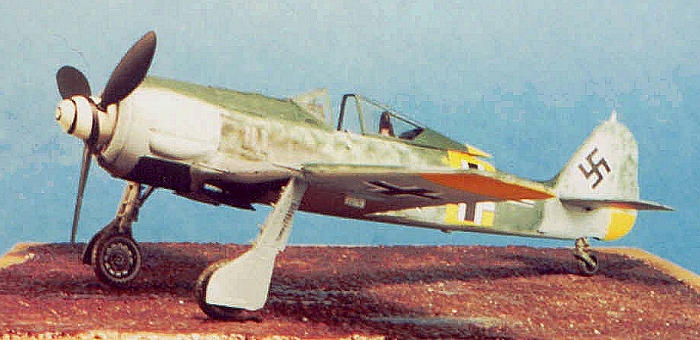
|
KIT # |
|
|
PRICE: |
$24.95 |
|
DECALS: |
One aircraft |
|
REVIEW & |
|
|
NOTES: |
Superscale 48-530 sheet used |

|
HISTORY |
Erich Rudorffer:
It is quite surprising that in this era when the great Luftwaffe aces of the Second World War are well-known to modelers, that one of the greatest aces is one who can certainly land on any list of the lesser-known.
Major Erich Rudorffer was the seventh-ranked Luftwaffe ace, with 222 victories, a score that opened in the Battle of Britain flying the Bf-109E with JG2 Richtofen and ended in April 1945 in an Me-262 as the Gruppenkommandeur of II/JG7. The fact he did not serve in the postwar Bundesluftwaffe, but rather opted to return to school and become a very successful corporate attorney might have something to do with his relative lack of renown today; the fact he was described as reserved and retiring personally may also be a reason.
Of his 222 victories, 74 were scored while flying in the west and in Tunisia, where he scored 27 victories during a three month sojourn in the desert war. Rudorffer was definitely a Focke-Wulf ace, inasmuch as 62 of his western victories were scored in the Wurger, and all his 136 Eastern Front victories were achieved Kurt Tank's fighter. His score of 12 in the Me-262 makes him the third-ranked German jet ace of the war, all of which were scored between early March and mid-April of 1945, during which time his primary focus as commanding officer was maintaining supplies and operational aircraft.
The Germans themselves consider that Rudorffer only had two peers in the Jagdwaffe when it came to gunnery skill: Hans-Joachim Marseille and Erich Hartmann. Rudorffer's specialty was multiple kills utilizing deflection and an economy of ammunition.
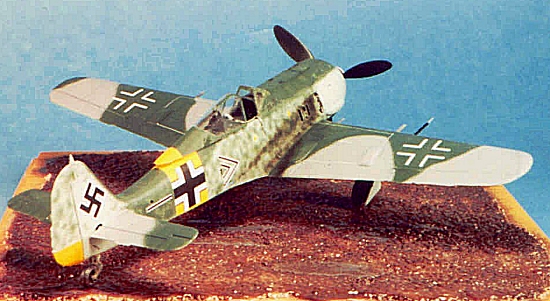 In a seventeen-minute engagement on November 6, 1943, Rudorffer shot down
thirteen Russian fighters, one after another. In February of that year, over
North Africa, Rudorffer shot down eight RAF fighters in one mission on February
9, following that on February 15 with seven more RAF victories in two missions.
Entering combat on the eastern front with II/JG54 that June, he scored eight in
two missions on August 24, and seven in one mission on October 11. After his top
score of 13 that November, he claimed eleven Russian fighters in two missions on
October 28, 1944. No other fighter pilot in any air force equalled this record.
Rudorffer was himself shot down sixteen times and had to bale out in nine of
those.
In a seventeen-minute engagement on November 6, 1943, Rudorffer shot down
thirteen Russian fighters, one after another. In February of that year, over
North Africa, Rudorffer shot down eight RAF fighters in one mission on February
9, following that on February 15 with seven more RAF victories in two missions.
Entering combat on the eastern front with II/JG54 that June, he scored eight in
two missions on August 24, and seven in one mission on October 11. After his top
score of 13 that November, he claimed eleven Russian fighters in two missions on
October 28, 1944. No other fighter pilot in any air force equalled this record.
Rudorffer was himself shot down sixteen times and had to bale out in nine of
those.
By May 1944, Rudorffer had been Gruppenkommandeur of II/JG54 since the previous July. By now, I and II Gruppen of the Grunherz Geschwader were the only dedicated air superiority units on the eastern front still equipped with the Fw-190. Though the Fw-190A-8 was available, Rudorffer and his pilots preferred the Fw-190A-6, which had the same cannon armament as the A-8, but did not carry the fuselage-mounted 13mm cannon, rather being still equipped with the 7.7mm weapons of the early-production Wurgers. Thus, the A-6 was the last of the lightweight radial-engined Fw-190s, which allowed it to maintain its edge in maneuverability over the Soviet opposition in air combat.
In the face of the Russian summer offensive, launched three days after the invasion of Normandy, JG54 had withdrawn from Russia into Latvia, moving south from Leningrad toward Germany. At the same time, the Finnish forces to the north of Leningrad came under heavy attack from the Russians. Up to this point, the Finns - though allied with the Germans - had largely fought their own war, being primarily interested in recovering the territory taken from them in the Winter War of 1939-40. However, as hard-pressed as they were now, the Finns asked the Germans for aerial assistance in stabilizing the Karelian Isthmus front.
II/JG54, with 34 operational fighters, flew to Immola to become the air superiority section of Gefechtsverband Kuhlmey, which included some 20 Fw-190F Schlactjaeger and Ju-87D Stukas from II/SG2. The unit operated from Immola for a month, during which the Wurgers of II/JG54 scored 66 victories, including ten by Rudorffer.
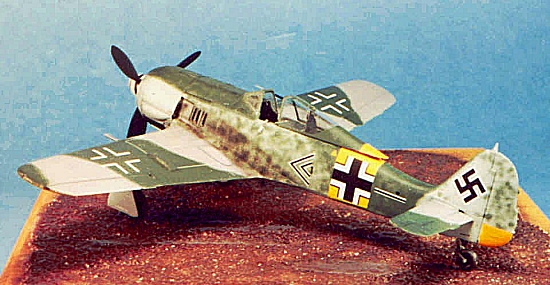 With the Karelian Front momentarily stabilized (though it would collapse
again that August, with the result that the Finns would sue for peace with the
Allies), II/JG54 returned to Latvia. By the end of August, the Grunherz had
retreated into the Courland peninsula, where the unit would fight on until the
end of the war in May, 1945, never having more than fifty operational Fw-190s
during this time. Their duty of providing air cover to the hard-pressed German
and Baltic forces meant they fought against Russian air units comprising a total
3,600 aircraft during the six Russian offensives against Courland. During the
first and second offensives in November and December, II/JG54 shot down 236
enemy aircraft at a loss of 18 for themselves.
With the Karelian Front momentarily stabilized (though it would collapse
again that August, with the result that the Finns would sue for peace with the
Allies), II/JG54 returned to Latvia. By the end of August, the Grunherz had
retreated into the Courland peninsula, where the unit would fight on until the
end of the war in May, 1945, never having more than fifty operational Fw-190s
during this time. Their duty of providing air cover to the hard-pressed German
and Baltic forces meant they fought against Russian air units comprising a total
3,600 aircraft during the six Russian offensives against Courland. During the
first and second offensives in November and December, II/JG54 shot down 236
enemy aircraft at a loss of 18 for themselves.
Rudorffer left II/JG54 in February, 1945, his place being taken by Hauptmann Herbert "Mungo" Fineisen. He then assumed command of II/JG7, the only Gruppe of the Geschwader to attain full operational capability.
The Focke-Wulf Fw-190A-6
The Fw-190A-6 is the main production version of the "mid-range" Wurger; the Fw-190A-3 and A-4 being the main versions of the early-production range, and the A-8 being the main version of the late production range. The fighter was intended for use on the Eastern Front, and the A-6 shared in common with the earlier fighters the fuselage armament of 2 7.7mm machine guns, and was the first version to be rid of the MG-FF 20mm cannon in the outer wing position, replacing this weapon with two MG151s similar to those carried in the wing root. It also was the first version to use the new lighter-weight wing that would become standard for all Fw-190s that followed. Over 1,000 Fw-190A-6s were delivered to the Eastern Front during the winter of 1943-44.
|
THE KIT |
There are two lines of radial-engine Fw-190s available in kit form. The first is from Tamiya, and includes the Fw-190A-3, the first main production version, and an Fw-190F-8 Schlactflugzeug; both are well-designed kits and a modeler can easily create a very nice model from either - with only a bit of effort, the Fw-190F-8 can be turned into an Fw-190A-8.
The other line of kits began life when released by TriMaster in the early 1990s. These expensive kits set a new standard, and were among the first injection-molded kits to provide photo-etch detail, and white metal landing gear. The kits were later acquired by DML, which released an Fw-190A-5, and Fw-190A-8. The kits are not as well-engineered and easily to assemble as the Tamiya Wurgers are, but many - including me - consider the final result a more accurate model.
|
CONSTRUCTION |
As a result of "The Big One" out here in January 1994, I had some models that were converted to spare parts, one of them being a DML Fw-190A-5. Among the salvaged parts was the early "flat" fuselage gunbay cover. Two years later, I ran across the SuperScale decal sheet, 48-530, on which were the markings for Major Rudorffer's Fw-190A-6 as seen at Immola in June and July 1944. It occurred to me that taking the early fuselage gunbay panel from the spares box and mating that with a DML Fw-190A-8 would make for an easy conversion to the Fw-190A-6.
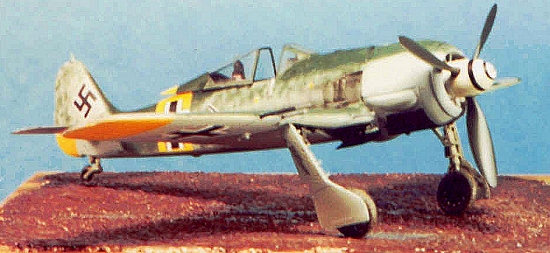 Studying the photos, I noticed I would also have to change the main gear
well, since the openings in the DML kit were for the later A-8 version which did
not have the inner wheel door covers. Trimming this area out and then making
scratchbuilt gear doors from plastic sheet was easy; the doors hang partly-down,
so some detail needs to be added to the interior surface, but not that much -
and there wasn't that much there anyway.
Studying the photos, I noticed I would also have to change the main gear
well, since the openings in the DML kit were for the later A-8 version which did
not have the inner wheel door covers. Trimming this area out and then making
scratchbuilt gear doors from plastic sheet was easy; the doors hang partly-down,
so some detail needs to be added to the interior surface, but not that much -
and there wasn't that much there anyway.
The main construction difficulties on the DML kits is the assembly of the engine cowling and mating it to the forward fuselage, and then mating the wing sub-assembly to the fuselage sub-assembly.
I use thin Evergreen strips, glued to the interior of the cowling parts, so that there is more there for the glue to grab, with the result of a stronger joint. I also use wider strips cut from Evergreen .010 sheet plastic, to make additional braces and joins on the forward fuselage where the cowling will touch. With this joint, it's even possible to pick up the completed model by the nose without fear that the engine will break off of the rest of the model.
The big problem with the wing-to-fuselage joint is that, if you do not get the fuselage spread wide enough, it will leave a very noticeable gap along the upper wing-fuselage joint, requiring a lot of putty and sanding with resulting loss of surface detail.
The solution is to cut off a piece of sprue the width of the interior of the fuselage right at the trailing edge of the wing. Test fit this part into the fuselage after the cockpit has been installed, and test fit the wing. When you have the fuselage pushed out wide enough to make the joint, glue the brace in position, then attach the wing. You won't use any putty this way.
Past these two items, there are no surprises in the assembly of the kit.
|
PAINT & DECALS |
Once the kit was assembled, I "pre-shaded" the model by airbrushing flat black along the panel lines. I then painted the lower wingtips and lower rudder with Gunze-Sanyo "Gelb 04" Yellow. I didn't have to paint the fuselage band, since that is a decal. I then painted the underside of the cowling Gunze Sanyo RLM71 Dunkelgrun. When these were dry, I masked them off with drafting tape, and applied the Gunze Sanyo RLM76 Hellblau to the lower surfaces and fuselage sides. I used Gunze-Sanyo "Neutral Grey" for the RLM75 Grauviolett, and my own mixture of Gunze-Sanyo IJN Green and Sea Grey for RLM74 Grau-grun. This was dappled over the fuselage, building up to almost a full overspray on the rear fuselage sides, per the photos of this airplane in the Monogram "Luftwaffe Markings and Camouflage" Vol. 3. The spinner was painted white, and the prop blades were painted RLM71. The wheel well interiors, gear legs and gear doors had been previously painted RLM02 before assembly, and the cockpit had been painted RLM66 Schwartzgrau. When all was dry, I unmasked the theater markings and shot the whole model with Testor's Glosscote.
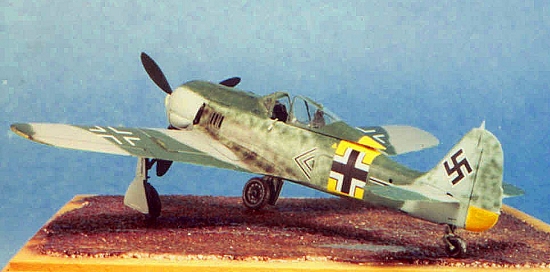 Decals:
Decals:
The SuperScale decals went on easily. I used the kit decals for the various stencil markings. When all was set up, I washed the model to get rid of dried-on decal solvent, and shot the model with another coat of Glosscote. When that was dry, I shot the model with two coats of Testor's Dullcote.
Weathering:
Photos show this airplane to be pretty clean, so I only put some "dings" on the wingroot where the pilot would stand as he climbed into the cockpit, with other small dings on the leading edge of the wing and the dzus fasteners on the cowling and gunbays. The BMW801 engine was notoriously dirty, so I did the exhaust stain with Tamiya "Smoke" on the fuselage sides and the lower surfaces of the wing and fuselage.
Final Assembly:
I attached the landing gear and cockpit canopy in position with cyanoacrylate, then attached the prop.
|
CONCLUSIONS |
The result, with an easy bit of conversion work, is one of the lesser-known varieties of Fw-190, flown by one of the lesser-known but greater German aces.
If you would like your product reviewed fairly and fairly quickly, please contact the editor or see other details in the Note to Contributors.